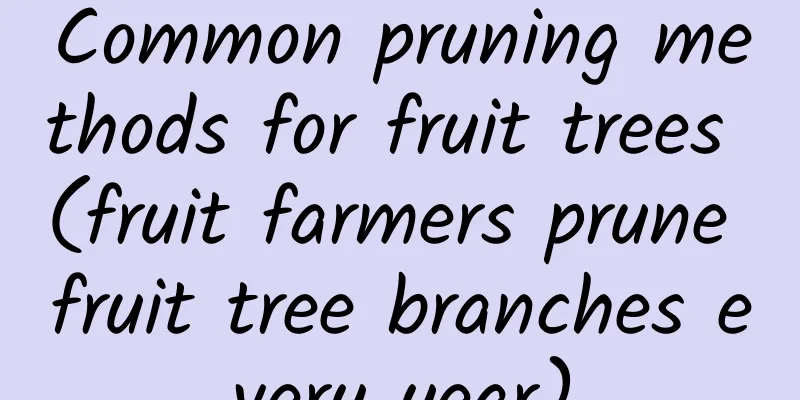Common pruning methods for fruit trees (fruit farmers prune fruit tree branches every year)

First of all, why do we prune branches and leaves when we plant fruit trees?As the crown of a fruit tree grows older and expands, too many branches and leaves will inevitably result in dense outside and hollow inside, premature aging of the tree, serious alternate bearing, and reduced fruit yield and quality. Therefore, we need to adopt some pruning techniques to reduce the occurrence of similar situations. 1. ShortenCutting off a part of the top and buds on the branch can concentrate nutrients, promote the buds at the cut to be dominant, and germinate into strong branches. The retraction of perennial branches is also a kind of pruning. Leaving nutrient branches below the cut so that they can extend again is called "reduction pruning"; not leaving leading branches below the cut is called "blocking", the purpose of which is to inhibit its growth, often forcing it to turn into branch groups. Generally speaking, the heavier the pruning, the stronger the local stimulation to the cut and the lower part, and the more severe the inhibition to the plant as a whole and even the root system. For newly planted fruits, do not prune too much, otherwise it is easy to cause slow fruiting. 2. ToppingThe main purpose is to remove the tender parts of the growing new shoots. The purpose is to inhibit the continued growth of the branch and promote the transfer of nutrients to the lower buds or their adjacent parts, which is conducive to flowering or fruiting. 3. ThinningThin out some branches and buds from the base. Because the nutrient area of the mother branch is reduced and some wounds are caused, the upper branches of the thinned branches will become weaker and the lower branches will become stronger. The overall effect of thinning branches varies depending on the type and amount of branches thinned. Thinning out weak branches, dense branches or overgrown branches can reduce useless consumption, increase effective photosynthetic area and benefit overall nutrition; but thinning out too many nutrient branches will reduce nutrient accumulation and weaken the root system and tree vigor. Operations such as bud removal and tip thinning during the growing season are also considered thinning and are more commonly used for evergreen fruit trees. 4. Slow downThe slow release is mainly based on the growth of fruit trees. The nutrient branches are not pruned and allowed to extend naturally, so as to utilize the weak apical buds to extend, gradually slowing down and weakening their apical dominance, thereby increasing the germination rate of the branch buds, promoting the growth of short branches, and inducing flowering. Slow release is usually combined with increasing the branch angle, and the effect is obvious when the branches grow nearly horizontally or obliquely downward. However, it is generally not used for overly vigorous upright branches. 5. Other pruning techniquesFor example, by means of scoring, ring cutting, twisting the tips or softening the branches, the organs or part of the conducting tissue can be injured, so that the direction or speed of nutrient delivery can be temporarily changed. This is also effective in alleviating excessive growth, promoting flowering and increasing fruit setting. The application of the above-mentioned pruning methods should be adapted to the conditions of the tree and the location, based on the growth and fruiting characteristics of different tree species and varieties, as well as factors such as rootstock, tree age, and tree vigor, while also taking into account the characteristics of natural conditions and the level of cultivation management. At the same time, we need to pay attention to the comprehensive application of various pruning methods and the coordination between winter pruning and summer pruning. |
Recommend
How often should I water Clivia?
Daily watering The roots of Clivia have the funct...
The role and benefits of indoor cultivation of green radish
1. Purify the air Pothos is a green plant with ve...
By the Erhai Lake, in the Moon Palace, she created a paradise with her heart
On the shore of Erhai Lake, Build an exquisite an...
Where does creeper grow? Can it survive the winter in the north?
1. Where is it located? Ivy can grow in a wide ra...
How to make lilies grow short and strong? What to do if they grow too tall?
1. How to grow short and strong 1. Maintenance an...
How to propagate Chinese rose by sowing
Treatment of rose before sowing Rose plants have ...
Planting time and method of yellow heart black cabbage, cultivation and management technology
Planting time of yellow heart wutacai Yellow-hear...
Which month is the best to plant taro?
The soft and sticky taro is very popular, especia...
What is the function and value of Colchicum
The role of colchicine Colchicum is a flower with...
What kind of fruit is the love fruit and what does it look like?
1. What kind of fruit is it? 1. Pitaya: It is als...
How to prune the roots of green radish
Does the green radish need root pruning? In daily...
Precautions for transplanting Schefflera chinensis: What is the best month for transplanting?
If you are transplanting from a small pot to a la...
How many days does it take for carrot seeds to germinate?
How long does it take for carrots to sprout? It t...
How to water succulents
Once lacking water, the leaves of succulents will...
Three things not to do when placing asparagus fern in Feng Shui: What are the Feng Shui considerations?
1. Places with inappropriate lighting Asparagus f...









